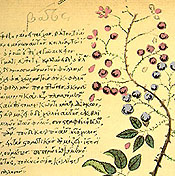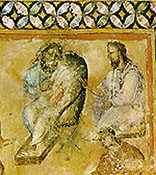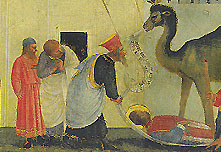VIENNA DIOSCURIDES
Dioscurides was a physician who resided in Rome during the first century. He composed a compendium of all the materia medica then known from Greek medicine and other sources. He may have learned his medicine by practical experience while in the legions and he most certainly relied on an earlier work by the physician Crateuas. His work describes some 600 plants and their possible medical use.Byzantine science was essentially Classical science. The value of a book like the Vienna Dioscurides was determined by the veracity of its illustrations. Eventually, copies became so bad that a movement was initiated to “clean up” the texts. Periodically, there were “renaissances”. In the 6th century CE, when this book was made, there was such a renaissance. It represents an attempt to rescue an ancient text. Illustrations are dependent upon various updatings. Thus, scientific illustration could only progress as fast as accurate illustrations could be made and consequently, science progressed pari passu with scientific illustration. It was only with mechanized type that this problem of lag-time could be overcome.
Vienna Dioscurides, 512 CE





